Last Updated on: February 5, 2025
Bird watching can be a challenging craft, especially for beginners. Since the basis of most identification guides nowadays is bird families, newbies may not find this the easiest way to begin their birding journey.
Bird color is a feature that often attracts attention, especially among those without a particular interest in this fascinating field. Many people describe unidentified birds by describing their color.
Hence…
Please read on if you’d like to know about the different types of yellow birds and get better at identifying them. Birding becomes more enjoyable when you name the yellow birds visiting your garden effortlessly.
A Closer Look at the Most Common Types of Yellow Birds
When you’re out in the field, the sight of bright yellow color in the green shrubbery can indeed be eye-catching. Even for non-birders, seeing common yellow birds resembling the sun’s color can be a breathtaking experience.
Most of what we see when observing a bird is its plumage or the coat of feathers that gives the bird its colors. Focusing on the overall color rather than comparing an actual bird to the one you see in pictures, analyzing every detail is an excellent start with bird identification.
Birds come in every shade that sometimes conceals them from the watchful eyes of predators. One way of identifying an unknown bird species is through their colors and markings, such as spots, stripes, bars, and patches.
For instance, the bold black stripes of the prairie warblers and the yellow patches on the chest of a male northern parula are excellent identifiers. Even the two white wing bars of the pine warbler are one of its distinctive characteristics.
Likewise, it’s interesting to know that some bird species have their females sporting a yellow shade, such as the paler yellow plumage of the orchard oriole. The same goes for the summer tanager and female and the scarlet tanager outside its breeding season.
Check out several of the most common types of yellow birds and their profile overviews:
1. American Goldfinch
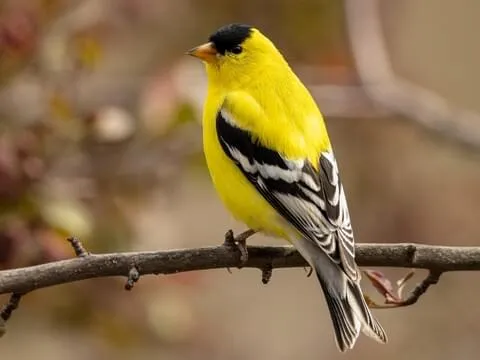
The male American goldfinch is a small bird sporting a bright yellow body contrasting its black cap during spring and early summer. It also has black and white wings. Unlike the European goldfinch, American goldfinches are completely yellow.
During winter, this bird looks drab with its brownish bill, yellow-colored throat and collar, fawn back, and blackish wings with a less prominent white wing bar.
On the other hand, a breeding American goldfinch female is olive-green above and dull yellow underneath. Many regions in the United States and southern Canada are home to this energetic breeder.
An American goldfinch likes inhabiting weedy fields, areas with low shrubs, suburbs, and deciduous woodlands. While it mainly feeds on plants like birch and alder, it gladly exploits thistle and sunflower seeds in backyard bird feeders.
2. Yellow Warbler

The yellow warbler is a long-distance migrant traveling to Canada and the United States, except in southeastern regions during its breeding season. It travels back to spend its winter in Central and South America.
This yellow bird has a prominent black eye, pointed bill, rusty streaked breast, and dull brown legs. Unlike other warbler species, this species has yellow tail spots, while the rest have white ones.
Prairie warblers are also primarily yellow, but they have prominent black streaks on their flanks. Comparatively, the northern yellow warblers have chestnut flanks, not black, and their faces lack any markings.
The yellow warbler dwells in wet, brushy habitats, swamp edges like willows and alders, gardens, parks, and riparian woodlands. Its main diet consists of insects, insect larvae, and fruits. Furthermore, it’s typical for this species to have their males sing a sweet song repeatedly during the dawn chorus and territorial disputes with other males.
Birdbaths with moving water are its weakness in backyards. Occasionally, these yellow warblers make a few stops at some trees to snack on some grasshoppers.
3. Yellow-Throated Warbler

Long-billed yellow-throated warblers are large, distinctive birds with yellow throats and upper breasts, unmarked grey backs, streaked flanks, bold white eye stripes, and black masks.
Females lack the lively appearance of males, looking drabber with a less significant black shade on their crowns. Also, the females have lighter streaks.
These warblers bear subtle markings that make them almost inseparable; you can hardly use these marks as identifiers when viewing them in the field.
Many birders sometimes mistake it for the yellow-rumped warblers, except the latter have less extensive yellow shade on their throats. In the eastern parts of the United States, such a warbler prefers breeding in open pine and deciduous forests where streams are nearby.
It is a casual visitor from the east to the western states, spending its winter in the far southeast and Texas, south into Honduras and the Caribbean. You will typically see such warblers foraging in palm trees when they are in their wintering range.
Moreover, this bird species benefit from its long bill when using it for prying into tree bark and foliages for insects, like caterpillars.
4. Cape Weaver
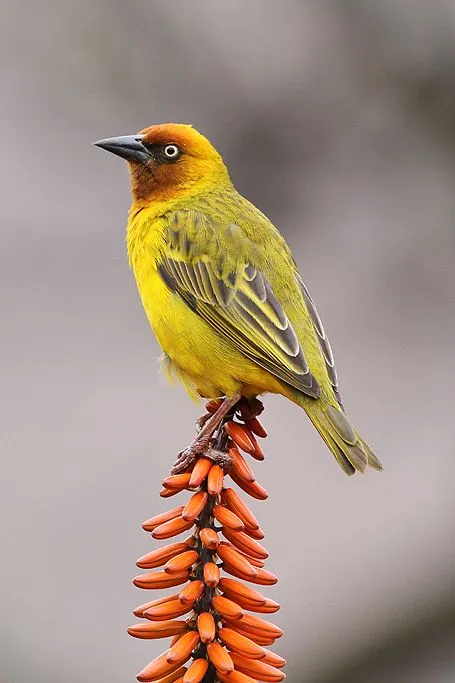
Male cape weavers feature dark-streaked wings, bright yellow underparts, pale eyes, and a tinge of orange on the face. You can distinguish a female cape weaver from the other weavers by its body size and bill.
The females and their juveniles’ heads and breasts are olive-brown, their eyes are brown, and their lower bellies show a more subtle yellow shade.
Since they are colonial nesting birds, you can expect these weavers to form a small flock of ten pairs. And despite their behavior of building the nest near other birds, male cape weavers can be highly territorial.
This weaver strongly prefers trees and reedbeds in woodlands, open grasslands, coastal thickets, and farmlands abundant in trees and water sources. It loves to eat insects, fruits, seeds, nectar, and sometimes, bread crumbs.
5. Yellow-Headed Blackbird
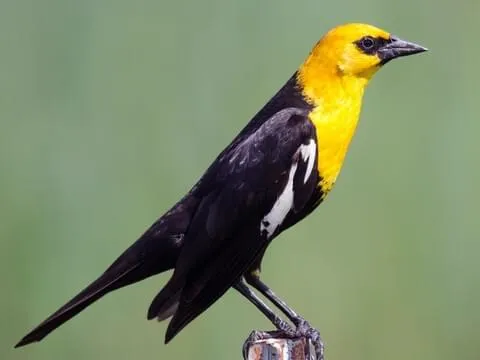
This blackbird is among the yellow and black birds with vast distribution from western Canada to the central and even the western parts of the US. It may have a widely fluctuating population, but locally, its presence depends on rainfall accessibility.
Breeding yellow-headed blackbirds opt to dwell in well-vegetated freshwater marshes, like cattails, and in loose colonies. Otherwise, you can see these birds in other wetlands with wooded areas where they prefer nesting in reeds over water.
The yellow-headed blackbird forages across farm fields, gleaning insects, grass seeds, and grains during the colder months.
The male has a bright yellow head and chest highlighting its overall black plumage, white wing patch, and long tail. By contrast, females are drabber, lacking the striking yellow shade of males, and have brownish plumage instead of black.
6. Evening Grosbeak
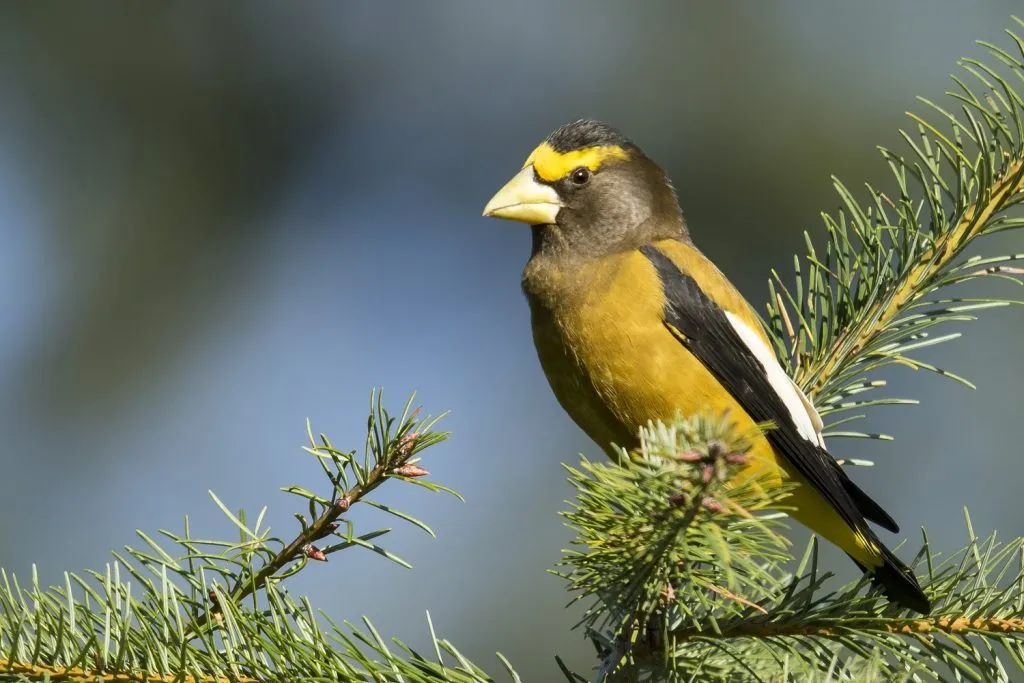
Aside from goldfinches, the evening grosbeak is another Fringillidae member showing significant bright yellow coloring mixed with some brown. It even has a yellow tinge underneath its wings.
The males sport dark heads, thick, conical bills, and a bright yellow stripe over their eyes, in addition to their black tails and white wing patches. Females look paler in their grayish plumage.
In addition to the pine siskin and snowy owls, these sizable finches are also irruptive species.
There is no discernible pattern to the invasion of evening grosbeaks in southern climes during winter. Over the past two hundred years, these birds have extended their range as far as the easternmost province of Canada.
Such changes could be due to the abundance of ornamental box elder plantations. The seeds of such plants provide these birds with a reliable food source in winter.
However, due to spruce budworm control measures, its eastern range has shifted northward recently. But despite the turn of events, a tray feeder full of sunflower seeds with surrounding trees and shrubberies can attract an evening grosbeak into your yard.
These finches have a reputation for boisterously feeding in flocks at backyard feeders. Meanwhile, it favors habitats such as the western mountains and coniferous forests and feeds on pine, conifer, maple, and box elder seeds. It sometimes eats insects and their larvae, too.
7. Yellow-Bellied Flycatcher
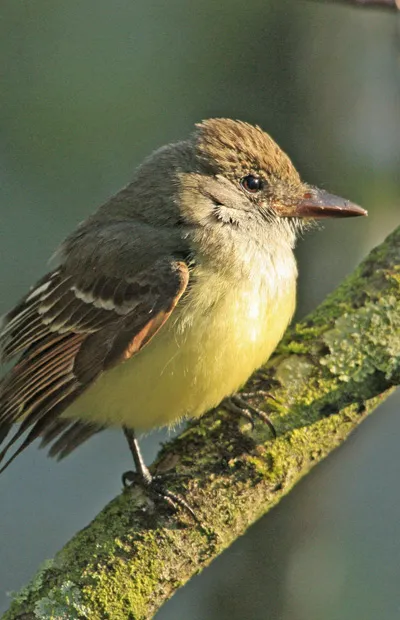
The yellow-bellied flycatcher may not be as familiar as the other yellow birds due to its preference for remote habitats. It likes nesting in the damp areas of boreal forests from Canada to southern Wisconsin and New York.
During the frigid winter, this bird is common in dense vegetations around south Mexico and Panama.
To recognize this bird, look for its oversized head, pale olive plumage, slight yellow belly, and yellow eye ring. Yellow-bellied flycatchers also show some white spots on their wings and tail feathers.
Moreover, these birds mainly feed on flying insects and mosquitoes; sometimes, they also eat seeds and berries in gardens.
8. Yellow-Breasted Chat
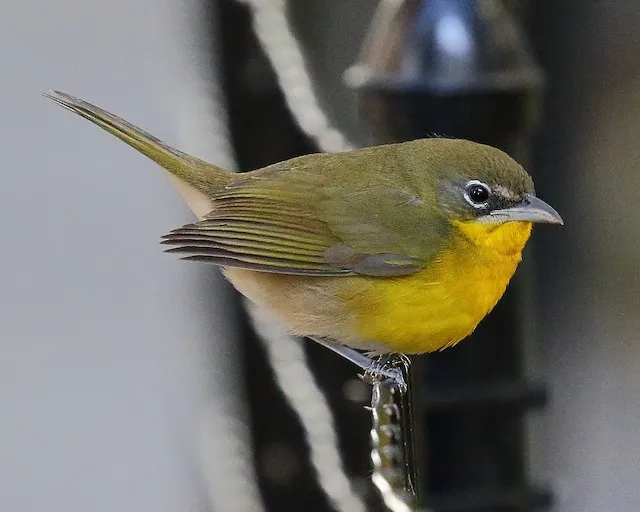
The yellow-breasted chat is the most sizable warbler with a vividly yellow breast contrasting its olive-green back, brown wings, and white underparts. These birds also have gray faces with white eye-ring that looks like spectacles.
Over the years, several experts have suspected that this bird is not a warbler due to its genetic data.
Sometimes, the yellow-breasted chats will exploit your gardens as they forage the bean leaves for some beetles. It can be tricky to spot at times due to its fondness for lurking in dense vegetations, like near eye-level thickets and bulky dead plants.
While its staple meal consists of insects, a yellow-breasted chat also feeds on fruits and berries. Many observers often compare this bird with the common yellowthroat, although the latter has a more petite body, shows less yellow, and lacks the spectacled look.
9. Yellow-Throated Vireo
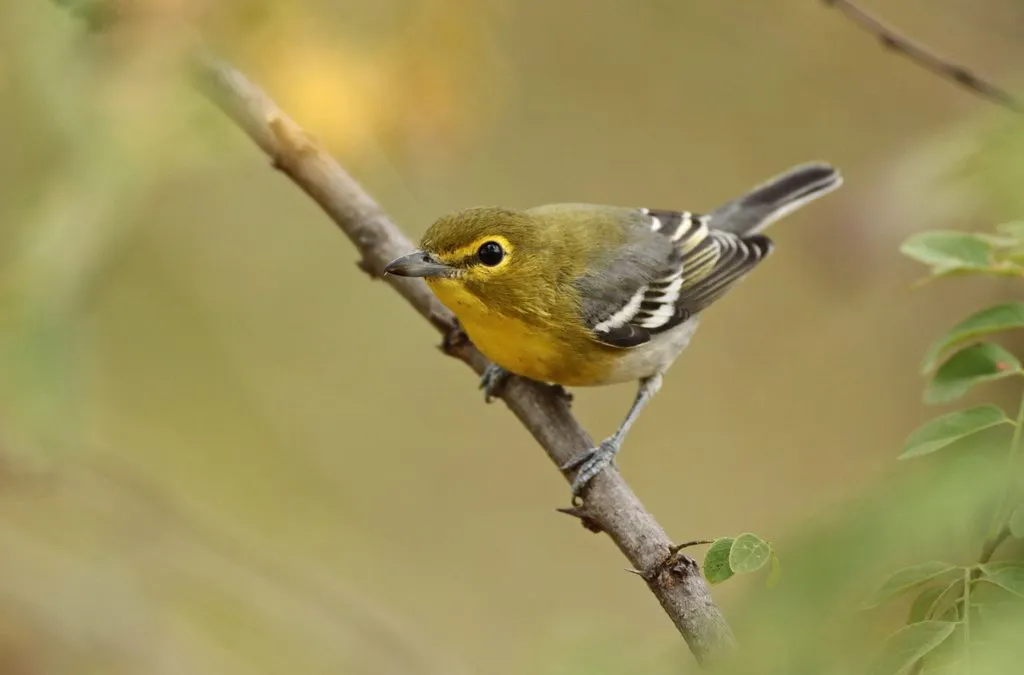
The yellow-throated vireo is well-known to most birders for singing about every two seconds with silent intervals between songs. This little creature is that songbird that looks like wearing yellow spectacles with a patch between its eye and bill.
The bird also has white wing bars on its dark gray wings, olive-colored back, yellow breast, and a short tail.
A yellow-throated vireo typically breeds in deciduous and mixed forests around the eastern regions of the United States. Nevertheless, various forest types are home to this Vireo in winter.
Peeling barks of mature trees provide yellow-throated vireos their food; it’s not unusual to see this bird foraging in high trees or picking insects from branches.
10. Nashville Warbler
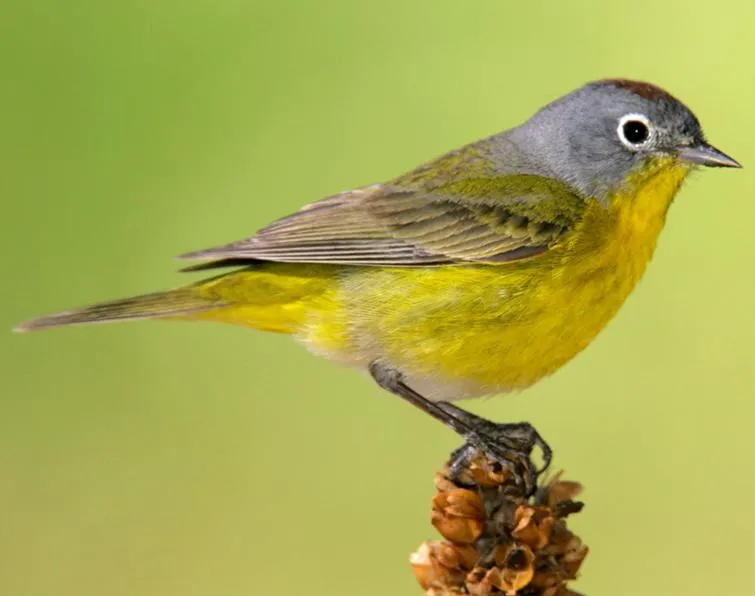
Nashville warblers are smaller than the Connecticut warbler and have eastern and western subspecies. The songbird of the west is recognizable with its gray head, rufous crown patch, white eye-ring, and greenish-yellow back.
Its eastern form has olive to greenish upperparts, and showcases rounded wings when in flight.
These warblers enjoy bathing in shallow ponds and birdbaths with other migrant species. Such a bird favors forest edges and open mixed woodlands and frequents brushy areas during migration.
Despite wintering in southern Texas to Mexico and central Honduras, Nashville warblers occasionally linger in the northern regions during the colder months. Moreover, it likes feeding on insects from trees.
11. Prothonotary Warbler
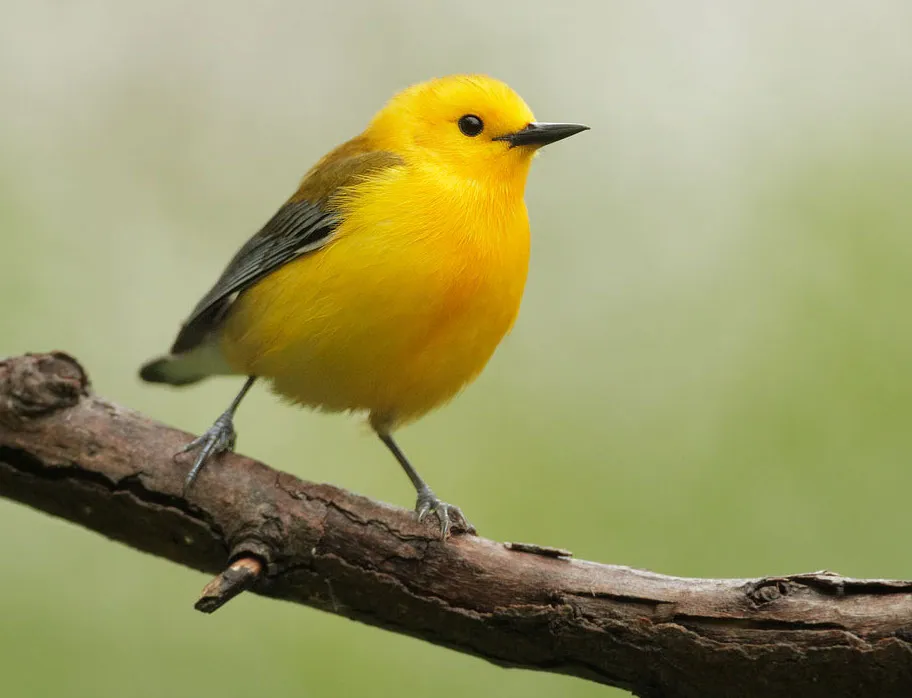
The prothonotary warbler is a swamp-dwelling species that solely represents the genus Protonotaria. It is among the small yellow birds that captivate the attention of many birders.
Besides its luminous yellow head, breast, and belly contrasting its blue-gray wings, the prothonotary warbler also has a longer bill than other warblers.
Its round, black eye stands out against the bird’s yellow face and a white tinge in the undertail feathers. Moreover, the females appear duller compared to the males.
This warbler has a typical foraging behavior of standing above slow-moving water. Also, when searching for food, you may encounter it hopping along branches and twigs of fallen trees.
It typically occurs in wooded areas where streams and lakes are nearby; prothonotary warblers prefer nesting in shady forests with dead trees previously used by woodpeckers. Such a warbler mainly feeds on insects and small mollusks; it sometimes eats seeds, nectar, and fruits.
12. Cedar Waxwing
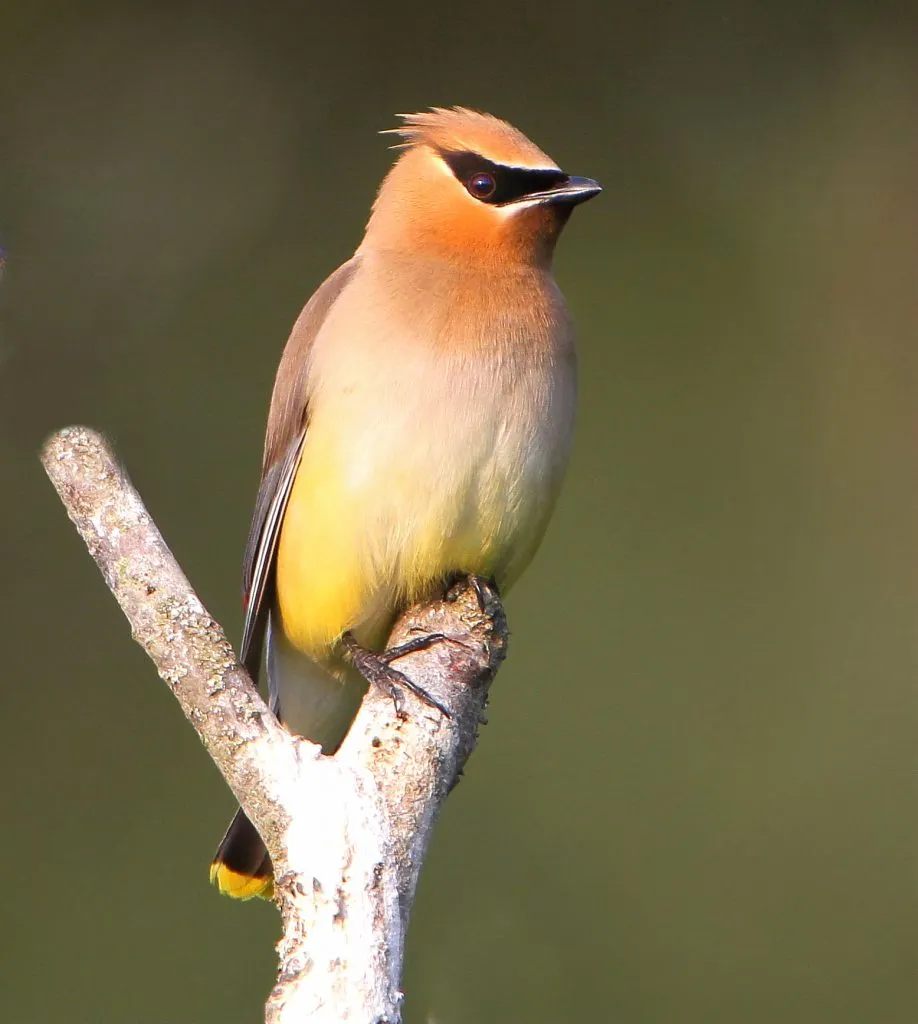
Like their other family members, cedar waxwings are well-known for their wax-like wing feathers. Hence, many birders from North America are familiar with this elegantly-looking bird that only breeds in that region.
As its name implies, a cedar waxwing highly favors cedar and juniper berries. However, these waxwings sometimes eat mistletoe berries and even help spread the seeds; likewise, they feed on flying insects in summer.
This beautiful bird is unmistakable with its tufted crest, brownish tan back, pale yellow belly, and black mask with fine white lines on its face. The waxy red tips on its inner wing are an excellent field mark that you might also want to consider when looking for this bird.
Generally, the bird spends much of its time in treetops. But it also occurs in areas where trees and shrubs with ripe fruits are abundant in winter.
13. Western Tanager
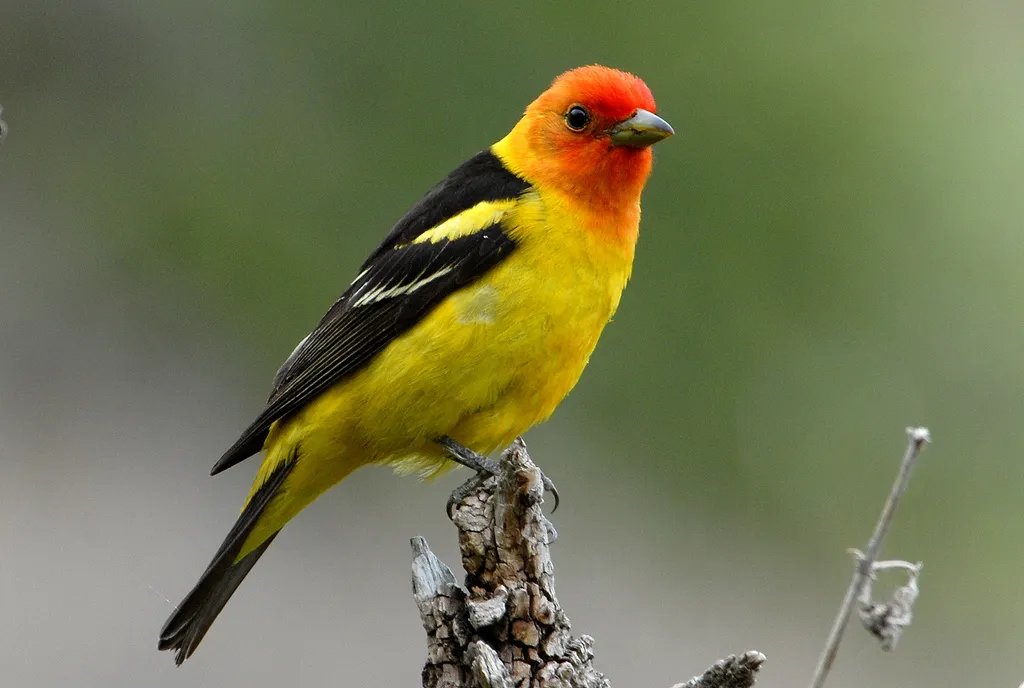
Male western tanagers have a distinctive song that many individuals hear from the coniferous forests in the western parts of North America. While singing from the treetops, you will notice how these males have a hoarse-sounding song resembling the American robin or the scarlet tanager.
You will have no trouble recognizing this eye-catching bird during nesting season with its jet-black wings contrasting its orange head and brilliant yellow underparts.
A western tanager commonly occurs in coniferous mountain forests, often catching insects in midflight as it flutters through its wooded habitat. While its habitat preferences vary per season, you will find it in mixed deciduous forests with mature aspen trees and alder groves..
Aside from flying ants and termites, ants, wood borers, grasshoppers, and cicadas are also among this tanager’s favorite meals. It forages in forest canopies and foliage; sometimes, a western tanager feeds on nectar, sliced oranges, and dried fruits from bird feeders.
Roaming Tip: We have more birds that carry a “sunny” character. Learn more about them — Birds With Yellow Bellies.
Watch This!
Frequently Asked Questions
What birds have black and yellow feathers?
Birds probably are the most vibrantly looking creatures on earth because several species can be delightfully colorful. The non-migratory yellow-faced siskin looks captivating with its bright yellow face, black markings on its body, and a black hood.
Even the common yellowthroat, occurring on the southeast coast of Alaska and southern Canada, has this bright yellow throat contrasting its black mask. Lastly, the western meadowlark is a bird species with a significant yellow throat more expansive than the eastern meadowlark.
What yellow birds can you see in South America?
The Cape May warbler is a yellow bird, smaller than a palm warbler, and typically occurs in the woodlands of Canada and North America. But despite its breeding range, it migrates to warmer regions in the south during the colder months.
Despite its increasing population in the northern US, the golden parakeet is another yellow bird from the south. The western tanager is a long-distance migrant spending summer in Canada and the western United States but flies to South and Central America during winter.
What is the name of that small bird with a yellow breast?
The blue tit is a little bird with striking blue feathers with a yellow breast. Such a species is generally a resident throughout its range and seldom travels far from home.
The Dickcissel is also among the small birds with a yellow chest highlighting its rufous shoulder and bold streaks underneath when outside its nesting season.
Conclusion
It is best, especially for bird-watching amateurs, to not only look for the colors of an unknown bird species. Doing so can be a misleading feature identification since, in some cases, the lighting condition may also affect how one sees the bird’s colors.
Focusing on color patterns instead of specific shades seems more practical and efficient. These yellow birds are indeed a spectacular sight to behold. But if we know them confidently, every encounter with them gets even more rewarding.
While bird watching can be a relaxing pursuit that you can do on your own, try interacting with other birders, too. As you share experiences, you not only gain new friends but broaden your birding expertise at the same time.

